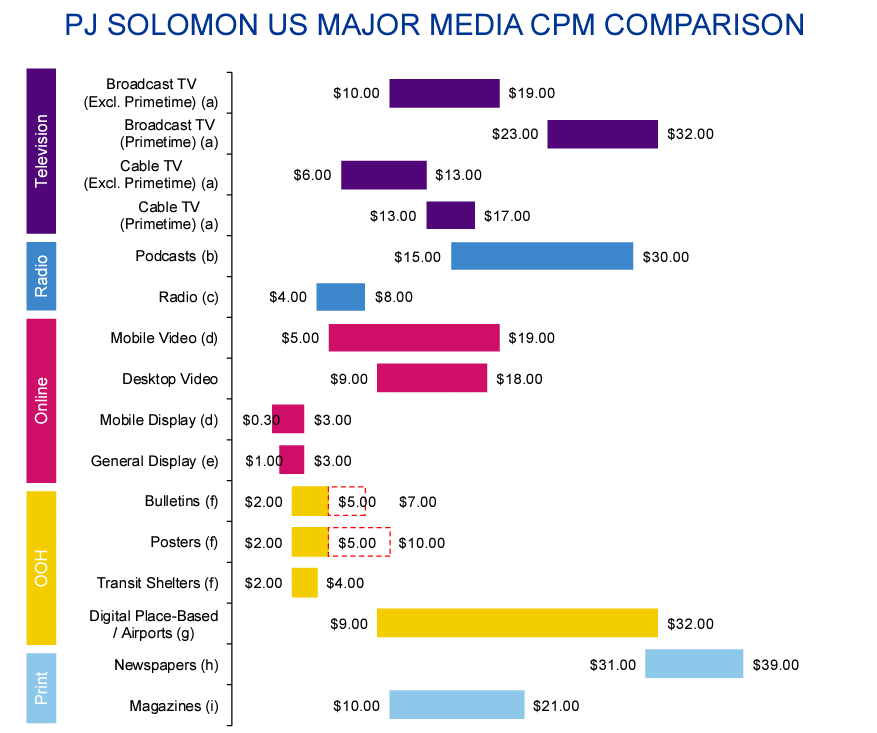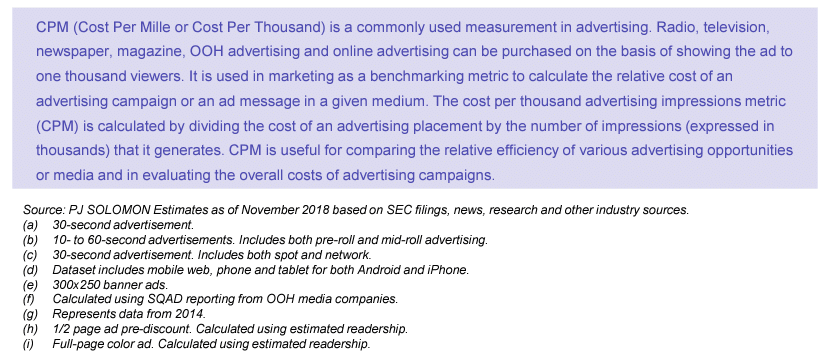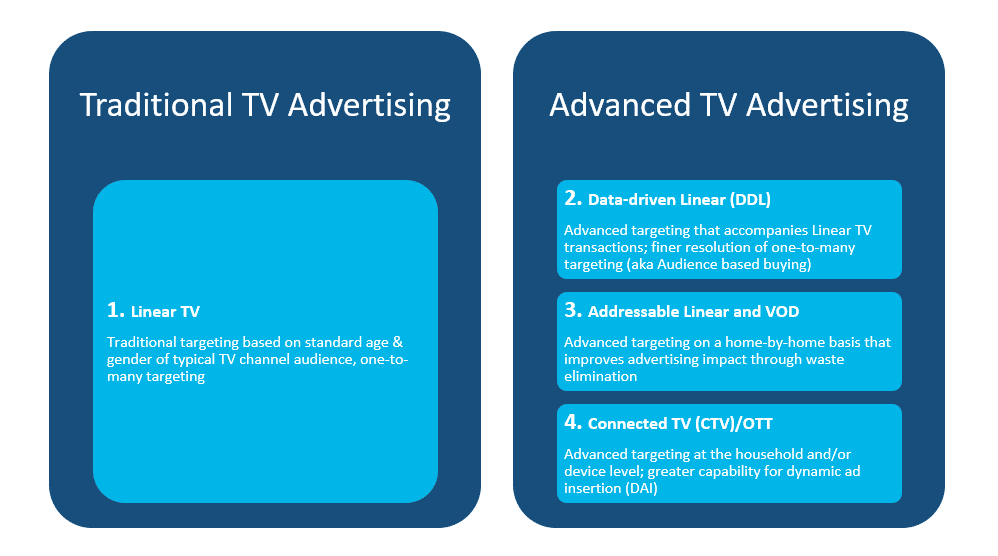The previous blog discussed the advertisement market and the digital advertising category specifically. Now we will take a closer look at the TV advertisement segment.
Effectiveness
In 2016 TV advertisements started losing market share; however, they still remain the most effective advertisement medium. One of the key metrics in evaluating the effectiveness of a certain advertisement medium is the level of attention an ad creative generates and what the associated cost is. In this context it is worth assessing the Attention Cost per Mille (aCPM) of each ad media.
When you have an advertisement on a website, it only takes up a small part of the screen real estate. An advertisement on the TV, on the other hand, takes up the full screen area, and in general those screens are also bigger. Therefore, the chances of the ad being watched are simply bigger for TV advertisements than digital and web advertisements.
On the other hand, there is a higher probability for an ad to be seen when it is presented in a lean-forward manner, like while watching YouTube on a mobile device versus when the user is leaning back or walking around the house while the ad is aired on TV.
There are differences in “seeing” too. Just because an ad is within one’s eyesight doesn’t mean that one effectively watches the ad. If you look at the time that people effectively watch what is presented — the so-called dwell time — you see that on average 13.8 seconds out of a 30-second TV advertisement is actually watched.


Additionally, if you look to the Attention Curve per Media graph (below), which shows the distribution of attention across the ad duration, then you can see that for TV the attention extends all the way through 30 seconds. Consequently, you can use almost the full 30 seconds to convey a more complex marketing or advertisement message.
So, the TV advertisement is a very powerful and effective medium.
Traditional TV Advertisement: Brand Awareness
When comparing advertisement costs across different media it is important to use the same metric. One approach is to use the Effective Cost Per Mille (eCPM) metric.
In the chart below, we see that TV advertisements yield higher eCPMs. The chart only considers traditional (i.e., linear) TV advertisements.
In this case we have advertisers who buy ad slots on a certain TV channel for a certain part of the day (i.e., prime time or non-prime time), in general associated with a certain type of TV program.


For example, a car company will want to do ad campaigns around car-themed programs. But this is a very coarse-grained way of advertising. It is not very effective, as it will not necessarily yield a lot of additional car sales. However, it can help the advertiser in creating what is called brand awareness. It basically produces visibility for the advertising company and then later when somebody really is in the market for the product being advertised, they might recall your brand.
Advanced TV Advertisement: Conversion
By implementing some level of targeting, it becomes possible to leverage the TV medium to not only drive brand awareness but also to support “conversion.” We talk about conversion, when someone takes an action, such as an online purchase or a call to your service desk. For example, presenting an advertisement for a certain car brand and model when we know that the person is looking to buy a car will yield a better return on investment of ad spend vs. a more generic TV advertisement campaign.
There are different approaches within a targeted advertisement, as illustrated below.
We discussed the traditional TV advertising approach, with its coarse targeting capabilities, in the previous section on brand awareness. Things become more interesting once we are doing what is commonly referred to as advanced TV advertising. Within this category we have several subcategories. Let us now discuss each of these in order of their level of targeting capabilities.

SRC: Coalition for Innovative Media Measurement: https://cimm-us.org/wp-content/uploads/2013/05/CIMM-Addressable-Workshop-Summary_7-31-19.pdf
Data-Driven Linear (DDL)
One of the first more advanced TV advertising options is called Data Driven Linear (DDL). With this approach advertisers buy advertising slots not only based on the high-level demographics of the people watching a certain TV channel and program, but also additional data that is linkable to a specific TV channel/program. For instance, the login and profile information provided when registering onto the website of the specific TV program. This data-driven assessment helps further improve advertisers’ ad campaigns.
Addressable Linear TV and VOD
The next level of targeting advertising is called addressable linear and VOD, or addressable TV. In fact, addressable TV is the targeting done by traditional TV service providers (i.e., telco and cable operators or MVPDs in the U.S.) for legacy technology, IPTV or QAM-based delivery.
In the U.S., for more than 10 years addressable TV has enabled targeting at the level of the household. So, theoretically you could end up with a different ad for every household and subscriber. You’re never targeting an individual subscriber but rather a group of subscribers. Subscribers are mapped — based on whatever data the TV service provider collects directly or indirectly — into what is called cohorts. This is a more generic grouping around shared characteristics, like geolocation, socioeconomics, and past interests. Cohort sizes vary greatly but expect to see them in groups of about 10,000 to 100,000 households. For special ad campaigns this can be substantially smaller (i.e., a few thousand households).
Consequently, households that fit into the same cohort will be presented with the same advertisement on their STB connected TVs.
Although the targeting is at cohort level, it increases the efficiency tremendously versus traditional linear or even data-driven linear advertisement.
Connected TV Advertisement
The Holy Grail in TV advertisements, which everyone in the industry is talking about, is the connected TV (CTV) advertisement.
CTV advertisement is about bringing the advertisement capabilities of “traditional” addressable TV to the new way of video delivery: adaptive bitrate (ABR) streaming, but at the same time leveraging more and more of the programmatic capabilities from the digital advertisement space to handle the massive amount of ad inventory that is unlocked by this approach.
Given that in CTV, we are now targeting with the same technology as used for digital advertisement, we can also do coordinated cross ad media and channel campaigns. By using a common ad tech ecosystem, one avoids always bombarding people with the same advertisement (known as frequency capping).
It also enables more elaborate campaigns. An ad campaign could start with an advertisement tease on the TV screen and subsequently follow up on the PC with a more interactive advertisement that includes a click-through to a portal where the product can be bought.
Consequently, we see increased interest by advertisers to use the connected TV ad medium in their campaigns.
Connected TV: The New Ad medium of Choice
In a 2020 iAB study, 21% of the surveyed advertisers indicated that in 2021 they would further shift ad dollars from traditional TV advertisement toward connected TV advertisement, with targeting and efficiency as being the main drivers for this shift.
In addition, the incremental reach is listed as playing a role in this transformation.

These types of campaigns have a more cost-effective CPM, which is also mentioned as a driver. Indeed, as you are targeting cohorts with more relevant advertisements you run more efficient campaigns with substantially less loss and consequently higher yield. That also translates into a higher average effective CPM for connected TV advertisements vs. more generic linear TV advertisements.
StandardMediaIndex (SMI), a company specialized in collecting effective advertiser spend, concluded that on average the effective CPM for CTV/OTT is 30% higher than traditional TV advertising. For more refined CTV targeting the eCPM premium can be substantially higher.

Within the TV advertisement space there is already a clear shift toward targeted advertisement, either using the more traditional addressable TV approach or the newer connected TV advertisement approach.
Conclusion
TV has always been the most effective advertisement medium. With the advent of the connected TV advertisement, we are bringing the ease and effectiveness of programmatic selling/buying and the targeting capabilities of digital advertisement to the TV. This enables TV advertising to regain its leading market position from digital advertising.
The blog in the series, will discuss some additional considerations that are expected to further accelerate the shift of ad spend from digital to TV advertising.
The Target TV Advertising Blog Post Series:
Digital Ad, DAI and SSAI – Part 1/5
The Crumbling Cookies – Part 3/5
Connected TV Advertising – Part 4/5










